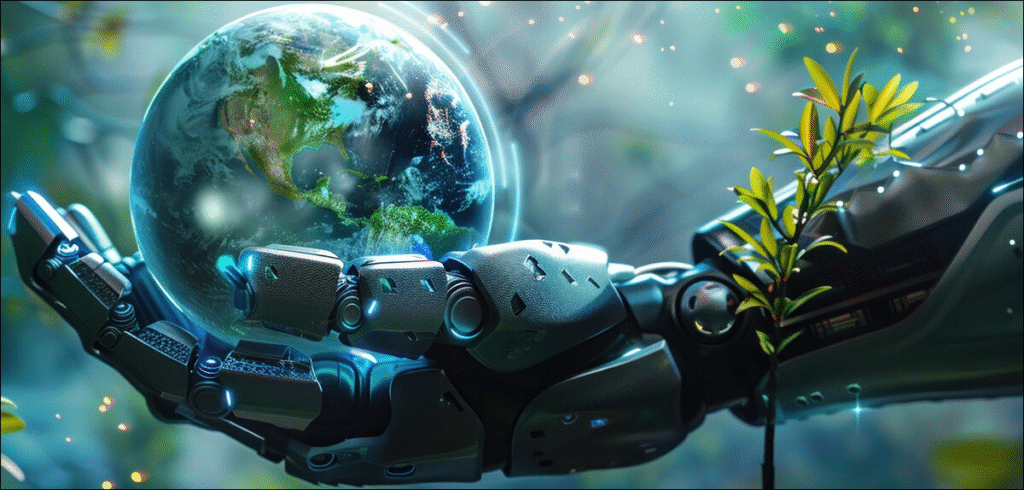What Is Blue Artificial Intelligence, Anyway?
Let’s keep it simple.
Blue AI is a type of artificial intelligence focused on oceans and water ecosystems. It collects information from oceans, analyzes it with machine learning, and helps predict or fix climate-related problems.
It’s called “blue” because it works with water — especially our oceans, which play a massive role in keeping Earth cool and healthy.
How Does Blue AI Work?
Here’s the idea:
- It gathers ocean data using things like satellites, buoys, and underwater drones.
- That data is sent to cloud servers.
- AI tools then study the data — looking for patterns or warning signs.
- If something’s wrong (like a rise in sea temp), alerts are sent out.
Think of it like a doctor for the ocean — constantly checking its pulse and giving updates before things get worse.
Real-Life Example
Let’s say a city near the coast is worried about hurricanes. Blue AI can look at ocean temps, air pressure, and wave patterns. It uses all that to warn about storms early. That means more time to prepare — and fewer lives at risk.
Simple Visual: How Blue AI Helps
Where Is Blue AI Being Used?
Let’s look at some cool examples where Blue AI is already doing good work.
1. Watching Coral Reefs
Coral reefs are dying due to heat and pollution. Platforms like ReefCloud use AI to scan reef photos and spot damage. This helps scientists act before it’s too late.
2. Smarter Fishing
Illegal fishing is a big problem. AI tools can now track boat movements and flag suspicious activity — helping protect fish stocks and keep oceans balanced.
3. Wave Energy & Shipping
Companies like Sofar Ocean use AI to forecast ocean conditions. This helps cargo ships use less fuel, which lowers pollution.
4. Predicting Floods & Tsunamis
By tracking underwater quakes and pressure changes, Blue AI can warn coastal areas much earlier than traditional methods.
Why Blue AI Matters (Right Now)
Our oceans are in danger. They’re warming, acidifying, and getting polluted fast.
But they also help us a lot — absorbing 25% of the carbon we release and over 90% of the heat from global warming.
If the oceans crash, so does the planet. That’s why Blue AI is so important.
Quick Comparison
| Feature | Without Blue AI | With Blue AI |
| Ocean Monitoring | Manual, slow | Real-time, fast |
| Decision Making | Delayed | Quick, based on insights |
| Disaster Alerts | Late warnings | Early alerts |
| Resource Use | Often wasteful | Smart & efficient |
Chart: Rise of Blue AI Projects
Every year, more organizations and countries are using Blue AI to solve climate problems. The growth is real — and fast.
What Makes Blue AI So Powerful?
Here’s what it brings to the table:
- Speed: It can process massive amounts of data in minutes.
- Accuracy: AI can detect patterns people might miss.
- Scalability: One system can cover thousands of miles of ocean.
- 24/7 Monitoring: It never sleeps — even when we do.
The Dream Team: Blue Artificial Intelligence in Climate Tech
Blue AI works even better when it teams up with other tools:
- Green AI tracks forests and farmlands.
- Urban AI builds smarter, cleaner cities.
- Satellite AI watches ice caps, wildfires, and drought zones.
Together, they create a full-picture view of Earth’s health.
Companies Making Blue AI Happen
| Name | What They Do |
| ReefCloud | Monitors coral health with AI image scans |
| OceanMind | Tracks illegal fishing with satellite AI |
| Sofar Ocean | Predicts wave patterns for safer ocean travel |
| BlueSky Analytics | Uses AI to track air and water pollution |
| Global Fishing Watch | Helps governments monitor fishing with data |
What’s the Catch?
No tech is perfect. Here are a few hurdles:
- Missing Data: Some oceans don’t have enough sensors.
- High Costs: Setting up and running marine AI isn’t cheap.
- Data Ownership: Who controls the data from global waters?
Even so, most experts agree that Blue AI is worth investing in.
What’s Next for Blue Artificial Intelligence in Climate Tech?
In the future, we’ll likely see:
- More affordable ocean sensors for wider coverage.
- Better sharing of global data between countries and research groups.
- Smarter climate models that include oceans more deeply.
- More policies shaped by AI insights, not just guesswork.
The goal is simple: act faster, save more lives, and protect our planet.
Final Thoughts
Blue Artificial Intelligence in Climate Tech is here — and it’s making a real difference.
It helps scientists, governments, and communities understand what’s going wrong in our oceans and how to fix it. From saving coral reefs to predicting storms, Blue AI is a game-changer.
It doesn’t just give us information — it gives us time. And in a climate emergency, time is everything.
FAQ: Blue Artificial Intelligence in Climate Tech

1. What is Blue Artificial Intelligence?
Answer:
Blue Artificial Intelligence (Blue AI) refers to the use of AI technologies like machine learning and data analytics to monitor and solve ocean-related climate challenges. It focuses on marine ecosystems, ocean temperatures, sea level rise, coral reef health, and more.
2. How does Blue AI differ from regular AI?
Answer:
Blue AI is a specialized form of climate tech AI that works exclusively with ocean and water-based data. While general AI may cover everything from finance to robotics, Blue AI focuses on understanding and protecting Earth’s oceans.
3. Why is Blue AI important for climate change?
Answer:
The oceans regulate Earth’s temperature, absorb carbon dioxide, and support marine life. Blue AI helps us monitor these systems in real time and predict disasters like floods, coral bleaching, and hurricanes — allowing faster action to prevent damage.
4. How does Blue AI collect ocean data?
Answer:
Blue AI systems gather data using satellites, ocean buoys, underwater drones, pressure sensors, and sonar equipment. This data is then processed using cloud-based AI models to detect patterns, threats, and opportunities.
5. What are some real-world uses of Blue AI?
Answer:
Some key applications include:
- Monitoring coral reefs with AI image analysis.
- Tracking illegal fishing through satellite data.
- Predicting tsunamis and floods based on ocean movement.
- Forecasting wave energy for cleaner shipping and offshore power.
6. Who is using Blue AI technology today?
Answer:
Organizations like ReefCloud, Sofar Ocean, OceanMind, and Global Fishing Watch are actively using Blue AI. Governments, environmental groups, and marine scientists are also integrating it into their climate response systems.
7. Can Blue AI prevent natural disasters?
Answer:
While it can’t prevent natural disasters, it can predict them earlier and more accurately. That gives governments and communities extra time to respond, prepare evacuations, or protect infrastructure.
8. Is Blue AI expensive to implement?
Answer:
Yes, at the moment, deploying Blue AI systems can be costly due to hardware, sensor setup, and cloud processing. However, as the technology becomes more common, costs are expected to go down.
9. Are there any downsides or risks with Blue AI?

Answer:
Potential challenges include:
- Gaps in data from remote ocean regions.
- Privacy concerns over shared marine data.
- Regulatory uncertainty in international waters.
Still, experts agree the benefits far outweigh the risks.
10. What’s the future of Blue AI in climate tech?
Answer:
Blue AI is expected to grow rapidly. In the near future, we may see:
- More global collaboration on ocean data.
- Cheaper and smarter sensors.
- AI integrated directly into climate policy planning.
- Better protection for coastlines, marine life, and fisheries.
